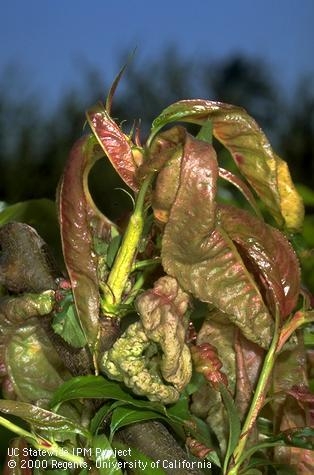Advice for the Home Gardener from the Help Desk of the
UC Master Gardener Program of Contra Costa County
Client's Request: Thank you for calling the UC Master Gardener Program Help Desk this morning with a question about your young peach tree.
You have a young tree, planted bare root into a pot in January 2018, and then transplanted directly into the garden in the late spring / early summer when you were able to do so. You planted several fruit trees at the same time, and all were planted initially into pots and then into the garden, in roughly similar locations, with good drainage in the garden. All of the trees have been similarly irrigated. All of the trees are doing well with the exception of the peach. The peach had curling leaves last year (every single leaf appeared wilted) and you would like to prevent this, this year. You are wondering whether this is “peach leaf curl” or something else, and whether or not to presume it was peach leaf curl and to spray now.

http://ipm.ucanr.edu/PMG/PESTNOTES/pn7426.html
If, after looking at these images, you decide that your leaves looked like this, then I would proceed as recommended in the UC Pest Note linked above.
If you do not think that your leaves looked like this, then we need to consider other possibilities. Wilted leaves can be evidence of a water transport problem in the plant. In this case, something in the vascular system isn't working as it should.
Beginning with the transplant from pot to garden last year, is it possible that the root ball was damaged? Or that there were air pockets in the garden created during transplant, causing some of the roots to dry out? Or that moles, squirrels or other garden visitors have created air pockets near the roots? If you think this is possible then I would dig down and fill those pockets with a wet-soil-sludge mixture to fill them in.
Is it possible that you have overwatered or that the drainage isn't quite as good as you had thought? Good drainage is one of the most important factors in siting fruit trees. Excess water in the root zone will produce a similar-looking result in the plant to a lack of water, since the roots will rot and cannot perform their intended function. In this case be cautious this spring with watering. Once the rains stop and you begin watering again, use a moisture meter or dig down 4 to 6 inches, and learn about your soil. Or perhaps you didn't water enough? Young trees are particularly susceptible to roots drying out. This link discusses irrigation of fruit trees:
http://ipm.ucanr.edu/PMG/GARDEN/FRUIT/CULTURAL/fruitwatering.html
Young trees have undeveloped root systems that are not very extensive. Because of this, your young trees need consistent moisture levels in their root zone in order to thrive. The "goldilocks" amount: not too much, not too little.
Some peaches are susceptible to root-feeding nematodes. Nematodes are tiny, eel-like roundworms. The species that attack plants are usually too small to be seen without a microscope, a soil test will be required. Here is a link to our local ist of soil testing labs for home gardeners. (http://ccmg.ucanr.edu/files/51308.pdf) Different labs perform different tests at different costs. I suggest that you call all or some of the labs to find out if they test for root feeding nematodes, whether or not the tests can provide definitive results, and the costs.
Inadequate nutrition from the soil can also result in discolored and crinkly leaves, look at the pictures at this link:
http://ipm.ucanr.edu/PMG/GARDEN/FRUIT/ENVIRON/nutrientdefic.html
The soil test can also provide information about the nutrition available in your garden soil, if you request this.
You mentioned that you purchased the tree from a local nursery. Although a few local nurseries (usually bigger stand-alone ones) also are a grower for some species, they do not grow their own fruit trees, they rather purchase them (this year, last year, and many years prior) from a grower specializing in fruit trees, often in the Central Valley or lately for citrus in the Monterey Bay area. You might take a look at one of the various grower nursery websites and look up the particular variety of peach that you purchased to find out what you can learn. Most of the nursery grown fruit trees are grafted on root stocks. Some rootstocks are resistant to root-feeding nematodes. It might be helpful to know whether you have a more susceptible tree by identifying the rootstock which can often be found in the grower's catalogue or web site..
Overall, this link will give you valuable information on planting, care, and irrigation of young trees. http://homeorchard.ucdavis.edu/8048.pdf
Good luck with sorting this out and please contact us if we can help further.
Help Desk of the UC Master Gardener Program of Contra Costa County (MCW)
Note: UC Master Gardeners Program of Contra Costa's Help Desk is available almost year-round to answer your gardening questions. Except for a few holidays (e.g., last 2 weeks December), we're open every week, Monday through Thursday for walk-ins from 9:00 am to Noon at 2380 Bisso Lane, Concord, CA 94520. We can also be reached via telephone: (925) 608-6683, email: ccmg@ucanr.edu, or on the web at http://ccmg.ucanr.edu/Ask_Us/. MGCC Blogs can be found at http://ccmg.ignore.edu/HortCoCo/ You can also subscribe to the Blog.